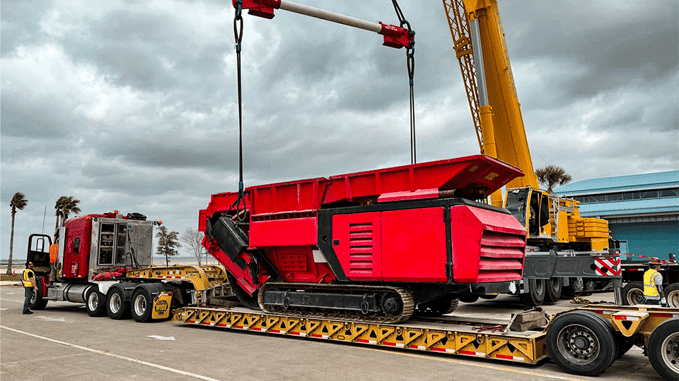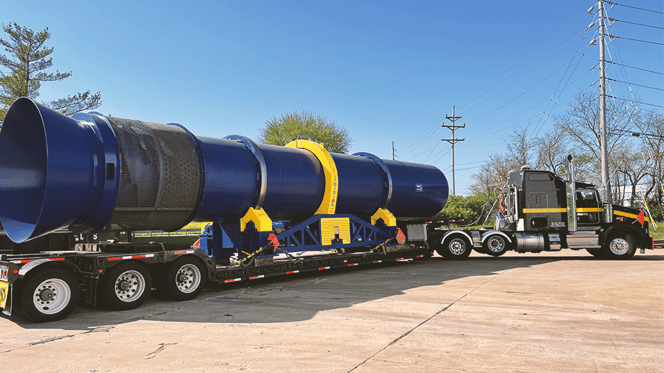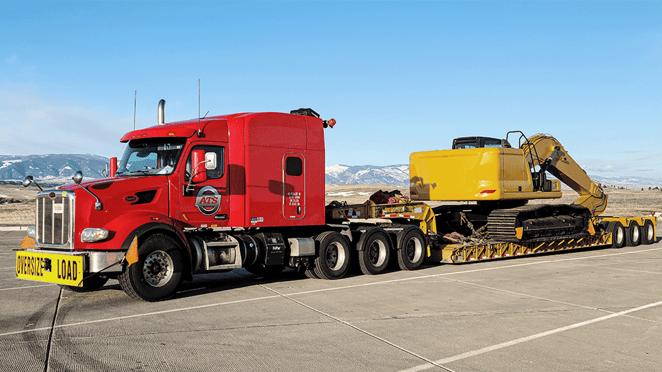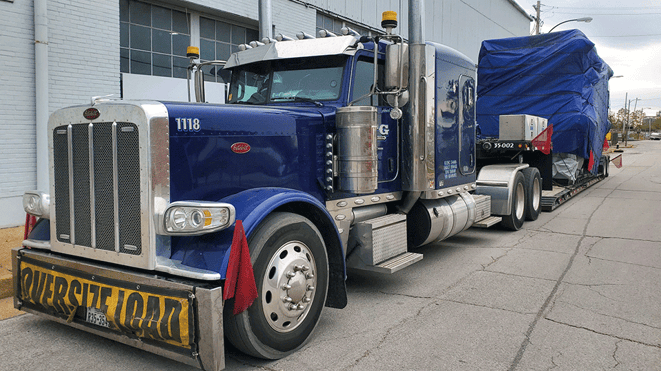Proper upfront planning is important to the success of any shipment, regardless of its size. In every scenario, deadlines need to be considered, dollars need to be allocated, a reliable carrier has to be contacted and communication must be comprehensive.
Moving over-dimensional freight, however, gets even more complicated.
In recognition of how important preparation is to the facilitation of your supply chain, you’re here looking for some information on what to expect when moving OD freight.
Feeling unsure as to what you should consider when preparing for an oversized shipment is totally understandable. That said, making the best transportation decisions for your oversized freight will require this knowledge.
Anderson Trucking Service (ATS) has been helping companies like yours move their oversized, over-dimensional and overweight freight for decades. During this time, we’ve seen the ease with which well-informed shippers handle these shipments — shipments that are far from simple.
You deserve to confidently plan, coordinate and execute your next over-dimensional freight move. This article will give you the tools necessary to do so.
Four key considerations you’ll want to keep in mind when managing the movement of your OD freight are:
- Your shipment’s route and timing.
- The space and dimensional barriers you’ll face.
- The heightened impact of weather.
- The additional costs associated with these moves.
Planning for these intricacies — intricacies that specifically apply to oversized freight — will be important in the days ahead. Handling this properly can mean the difference between smoothly executing your freight shipment and failure, leaving you with an over-extended budget and unhappy stakeholders.
Consideration #1: Your Freight’s Route and Timing
This first consideration, although complex, is important to grasp.
You see, your shipment’s chosen route directly impacts the in-transit and delivery timing it achieves.
That said, selecting the best-fit route for an over-dimensional shipment is largely influenced by a variety of time constraints. So. . . yeah, this can get a bit confusing.
The timeframe considerations for legal loads are relatively simple; the distance a shipment needs to travel impacts its transit time while the current state of your driver’s hours of service clock influences the delivery timeframe possible.
Sure, things like road construction and traffic may throw a legal shipment off of its normal route and projected timelines. But, more often than not, legal loads can be routed in the most direct manner possible — without worrying about travel curfews or restrictions.
Oversized freight shipments have a different reality.
Getting your OD freight moved efficiently takes comprehensive route planning based on information that must be collected at state, county and municipal levels.
Unlike a legal shipment — which can be moved with as little as 24-hours of lead time — these arrangements must be made well before a shipment is slated to load.

Although this is by no means a comprehensive list, here are some of the additional route-specific intricacies that accompany oversized shipping:
1. Travel curfews that change by area, such as:-
- Daytime only restrictions (limiting OD travel to daylight hours).
- Nighttime only restrictions (limiting OD travel to nighttime hours).
- High commuter restrictions (keeping OD loads away from commuter traffic).
- Holiday restrictions (preventing over-dimensional freight from transiting over holiday breaks).
- Weather-related OD freight movement prevention (high winds, slick roads, harsh precipitation, sub-zero temperatures, all impact OD freight first.
- Road construction (can quickly throw an OD shipment off course by restricting travel).
2. The acquisition of oversized permits
Though the length of this process will vary based on the locations/roads your freight traverses and the complexity of your load, budgeting enough time for permit acquisition (which can take upwards of a week or more) is foundational for OD transportation.
Related: How to Get Oversized Load Permits For Your Freight (3 Easy Steps)
3. Securing the service of area resources (where applicable) like:
-
- Engineering firms
- Utility consultants
- Police escorts
- Pilot car operators
-
- Route surveys
- Bridge inspections
- Notifying the proper authorities and jurisdictions.
Each additional step your shipment requires (these are often non-negotiable when legally necessary) will increase the time it takes to get get your load moving. Failing to plan for these ahead of time, and treating your shipment’s route like it's of legal dimensions, can leave you at a severe disadvantage in both time and money.
Consideration #2: The Intricacies Accompanying Oversized Dimensions
The second thing that you’ll need to keep in mind when moving your over-dimensional load is tied to its size.
These complexities can be broken into two categories: the relationship between size and price and the relationship between size and space.
1. The Relationship Between Size and Price
When it comes to moving oversized cargo, a single extra inch in cargo height, width or length can mean adding another thousand dollars (or more) to your freight rate.
For this reason, getting the most from your budget will require a firm understanding of how the size of your product relates to the price of moving it. That said, working through this on your own can get really difficult.
As you’ll discover, the requirements governing oversized freight movement are far from universal. In fact, it’s not unusual for the rules impacting your load to change multiple times per trip.
While goods are officially oversized at relatively dependable thresholds — when total loaded dimensions exceed 8 feet, 6 inches wide, 13 feet, 6 inches high and weigh more than 80,000 pounds — the price of securing permits can change greatly between municipalities.
The point at which oversized shipments demand special safety precautions also changes from one location to the next.
However, when your load’s dimensions qualify, arranging escort services (ranging between 2-3 dollars per mile), conducting route surveys and performing engineering work, can’t be avoided.
To avoid being caught off guard by expensive permits and “super load” classification, it’s important that you work closely with a trusted transportation company.
Ask this provider about the dimensions you should consider when developing your product. Request that they do a survey of potential routes and report back with estimated costs for moving products sized like yours. A great partner will be happy to help you navigate these waters.

2. The Relationship Between Size and Space
Due to their complex nature, it’s not uncommon for companies that are used to moving legally-sized freight to face issues when transporting OD products.
And who can blame them? Without the benefit of experience, trial and error, it’s nearly impossible to know what to watch out for, let alone plan around. As a result, many companies forget to plan for the dimensional constraints they’ll face at each step of this process.
For example, you don’t want to find yourself in a situation where the overall height of your cargo once loaded onto a trailer exceeds what the door of your facility will allow.
While this may seem like a silly mistake, some companies run into physical spacing issues on the front and back ends of their loads.
As such, be sure to plan for the additional height a trailer will add to your shipment (which can range between 12 and 60 inches depending on the trailer used).
Width is another factor to consider.
Some oversized shipments face troubles before, during and after transit because of their width. Perhaps the yard gates at your pick-up location are too narrow or there isn’t enough room to unload at the delivery location.
Whatever the case may be, make sure to take comprehensive route measurements and consult a transportation company during the engineering/development phase of your manufacturing processes. Doing so will help you avoid the massive delays stemming from a lack of space.
Consideration #3: The Heightened Impact of Weather
Seasonal weather changes impact the movement of all trucks, no matter what size of freight they’re hauling. Both legal and oversized loads face safety concerns when harsh weather — like heavy winds, winter storms and icy roads — pops up.
When these instances occur and weather patterns make things difficult, the movement of oversized freight is typically the first to be impacted.
The sheer size of these shipments makes safety a concern even in the best of circumstances. Without recognizing this and planning around seasonal shifts in weather (temperature fluctuations in the Northern United States, slick roads in mountainous regions, etc.) companies often see their supply chains stall unnecessarily.

Needless to say, you’ll want to avoid these issues wherever possible.
Make sure that you’re hypersensitive to changes in the weather when moving your over-dimensional goods. Some of the things to keep in mind are:
- Changes in the hours of sunlight available for OD freight movement from September through April.
- The impact of frost laws and spring thaw across the mid to upper United States in late March/April.
- The added challenge — and cost — of moving oversized goods around mountainous regions like Colorado and Utah during winter.
- The issues stemming from moving OD freight during hurricane season in Southern portions of the United States.
When companies, like yours, fail to plan for these intricacies — which disproportionately impact oversized shipments — prolonged issues occur.
And, if you’re worried about how the time of year, and its accompanying weather patterns, may impact your load, reach out to a trusted transportation company for these insights.
Consideration #4: The Additional Costs Associated With Oversized Shipping
This final consideration ties directly into the previous three. You see, moving exponentially large cargo is often far more expensive than many shippers anticipate.
Here are some price factors, exclusive to oversized shipping that you’ll want to budget for:
- Over-dimensional surcharge(s)
- The acquisition of permits
- Higher fuel consumption (and therefore costs)
- The procurement of all necessary safety services
For the most part, the final price a shipper pays for these factors comes down to how well they are planned for.
A one-off shipment — or even a project of OD freight — doesn’t have to break the bank. Without making these considerations, however, maintaining a budget can be next to impossible.

Make sure you plan using market insights, provide plenty of lead time and give your transportation providers flexibility whenever possible. In doing so you shouldn’t have any issues moving your oversized goods from A to B cost-effectively and without error.
Related: What Does Heavy Haul Trucking Cost?
Trust Your Freight to The Best!
Now that you understand how weather, time, space and cost considerations will impact the success of your oversized shipments in ways disproportionate to other cargo types, you know how important your transportation partnerships will be for this process.
Selecting a great company isn’t always easy though.
To help you align your shipping needs with the capability of the providers you utilize, we’ve put together a free heavy haul carrier vetting tool.
Download The Heavy Haul Carrier Selection Checklist (a 36-question checklist for vetting heavy haul trucking companies) and ensure that your next provider is the right fit — long before mishaps occur.
Finally, here at ATS, we understand what’s at stake for you. Without getting your OD cargos transported reliably, safely and on time your customer relationships will suffer.
If you’d like to discuss how ATS’ fleet of asset trucks and/or brokerage division can help you achieve your goals, please reach out today. We’re more than happy to help you in any way you need.





